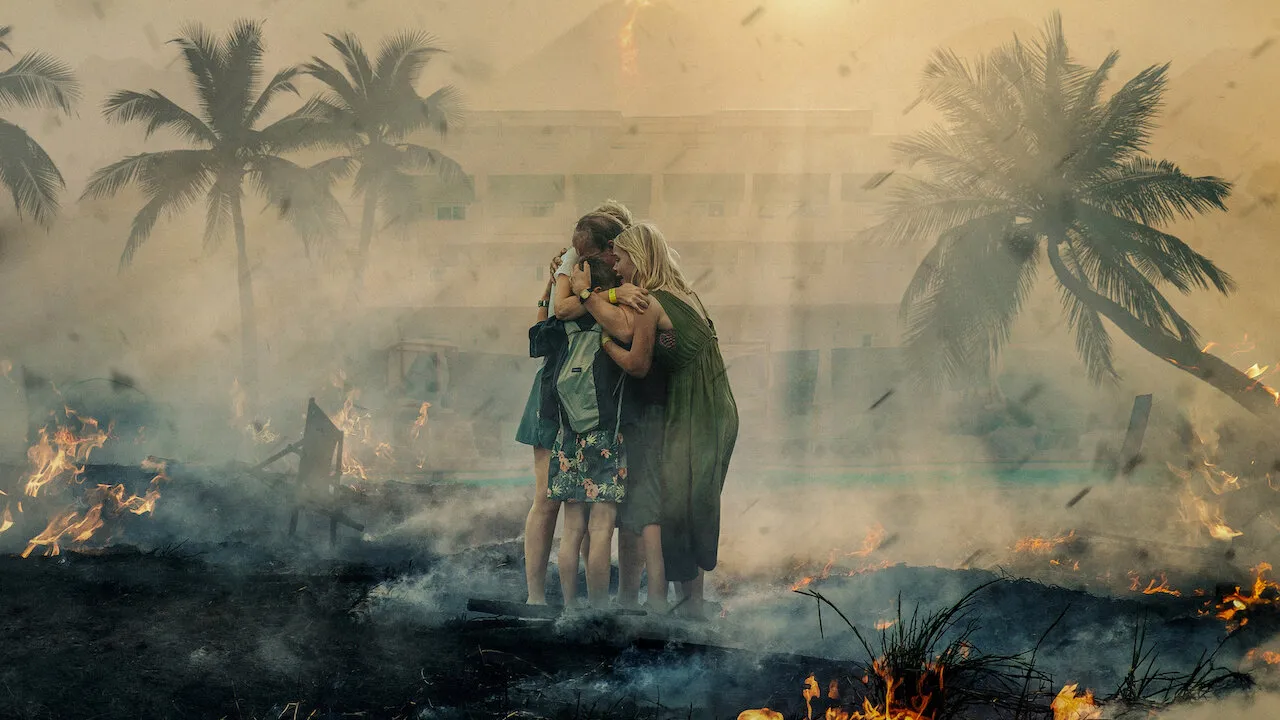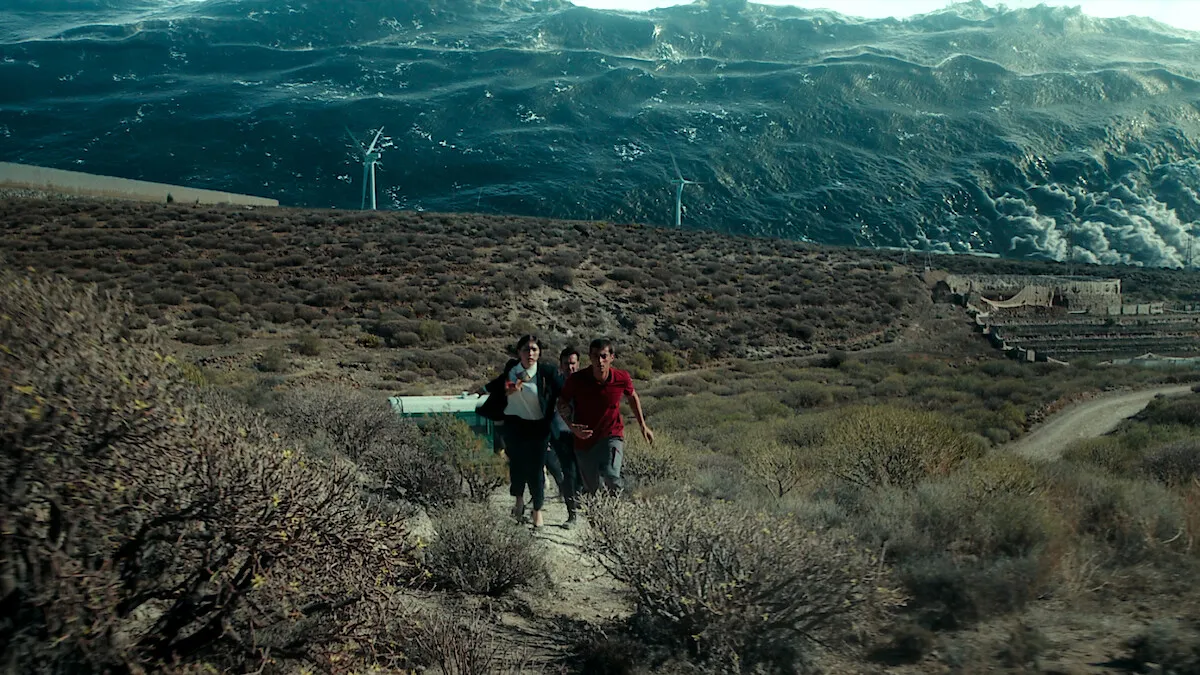La Palma transports viewers to the lovely world of a Norwegian family’s Christmas celebration in the Canaries. Initially, we are treated to colorful scenes of sun-kissed beaches and familial warmth, creating a nostalgic environment that many vacationers can connect to. However, a devastating volcanic eruption quickly interrupts this exquisite environment, turning their holiday into a frantic fight for survival.
The film uses a nonlinear storytelling style, combining lighthearted family moments with the growing tension of imminent disaster. This move not only heightens the tension but also reflects broader cultural concerns about climate change and nature’s unpredictability. The volcano acts as a powerful metaphor, echoing the fractures within the family dynamic, much like the narrative structure of French New Wave directors who worked with narratives to prompt reflection.
La Palma visually contrasts the bright hues of the festive season with the volcano’s harsh, frightening presence. The music design enhances this duality by oscillating between bright themes and dark undertones, while the cinematography captures beauty and dread. This multi-layered approach deepens the narrative by allowing viewers to reflect on their interactions with both nature and one another. In doing so, La Palma questions typical disaster clichés, reminding us of the fragility of joy in an uncertain world.
Exploring the Heart of La Palma: A Character Study
La Palma’s core is a finely detailed Norwegian family, with each member embodying problems that correlate with contemporary societal fears. Father Fredrik struggles with the weight of parental expectations and his inadequacies.
His desire for stability is at odds with his growing detachment from his wife, Jennifer. Fredrik’s character played with delicacy, highlights a prevalent tension in modern relationships: the comforts of routine can disguise deeper concerns that threaten to rend the fabric of family life.
Jennifer is on a quest for physical and emotional improvement. Her commitment to exercise is a metaphor for her desire to regain control in an increasingly chaotic life. However, this fixation exposes flaws in their marriage, revealing the often-unspoken pressures women feel when combining personal goals with domestic responsibilities. Jennifer’s story exemplifies a generation seeking self-actualization among the demands of parenting.
Sara, their adolescent daughter, embodies adolescent complexities. Her social anxieties and emerging identity are vividly shown, making her relatable to anybody who has navigated the tumultuous waters of adolescence. Her psychological problems are skillfully captured in the film, allowing viewers to identify with her quest for connection in a world that feels overwhelming.
Meanwhile, Tobias, the youngest sibling, is portrayed as a neurodiverse character with sensitivity. His distinct point of view enriches the narrative by highlighting the importance of sibling relationships and the difficulties families experience while trying to understand and support one another.
Supporting characters like Marie, the dedicated young scientist, add to the narrative. Her determination to raise awareness about the volcanic hazard adds an important aspect to the story, as she embodies the intersection of scientific investigation and human interests. Her coworkers, lvaro and Haukur, offer a backdrop of competence that grounds the disaster portions of the film in realism. Their figures reflect the often-overlooked heroes of the scientific community, reminding us of their critical role in protecting lives from nature’s whims.
These character journeys are expertly woven into La Palma’s main narrative, making each moment of tension and success reverberate powerfully. The film entertains and functions as a mirror, reflecting the complexities of modern family dynamics against the backdrop of existential threats, a theme that feels increasingly pertinent in today’s cultural landscape.
Unpacking the Themes of La Palma: Family and Nature in Crisis
La Palma expertly weaves together family dynamics and environmental urgency themes, creating a profoundly relevant narrative today. At its core, the film investigates the complexities of shattered relationships inside the Norwegian family. Fredrik and Jennifer’s marriage is a heartbreaking representation of many modern relationships, showing how routine can conceal deeper issues.
As the disaster progresses, the stress of survival exacerbates their problems, pushing each family member to confront their vulnerabilities and wants. This tension becomes a crucible, exposing the fragility of familial connections in the face of existential dangers.
The portrayal of Sara and Tobias adds to the exploration. Sara’s social anxiety and Tobias’ neurodiversity emphasize the various ways people deal with crises, demonstrating how disasters can bring families closer together or push them apart. The film conveys these relationships with a sensitivity that feels genuine, engaging with viewers who have faced similar struggles in their own lives.
However, La Palma is more than just a study of human interactions; it is also a powerful statement on climate change and humanity’s delicate relationship with nature. The approaching volcano eruption is a metaphor for our environment’s unpredictability, a theme that feels more important today.
The film cleverly incorporates environmental lessons to encourage viewers to reflect on the repercussions of ignoring nature’s warnings. This intersection of personal and ecological problems represents a generational transition in which viewers become more conscious of the stakes involved in our interactions with the world.
La Palma’s beautiful cinematography enhances these themes visually. The juxtaposition between the lovely holiday scenes and the looming threat of the volcano highlights the core duality of human experience—joy and peril. The sound design heightens this tension by oscillating between calm melodies and frightening nature rumblings, creating an audio landscape that matches the protagonists’ emotional travels.
La Palma employs a narrative approach reminiscent of independent cinema, emphasizing character-driven storytelling above spectacle. This strategy enhances the film’s emotional effect and aligns with the current trend of filmmakers challenging established genre norms. Like the works of directors such as Greta Gerwig and Noah Baumbach, La Palma delivers a subtle investigation of modern life, utilizing disaster as a backdrop to delve into the complexities of human connection and our obligation to the world around us.
Visual and Technical Execution in La Palma: A Cinematic Journey
La Palma succeeds at visual storytelling, using cinematography to portray the dramatic contrast between the lovely vacation location and the perilous volcanic landscapes.
The island’s lush, brilliant colors—sun-drenched beaches and verdant foliage—initially conjure a sense of paradise, drawing viewers into the family’s vacation experience. However, as the tension builds, the cinematography changes radically, depicting the volcanic terrain in darker, more menacing tones. This duality heightens the emotional stakes by embodying the film’s themes of fragility and approaching tragedy.
Lighting is vital in establishing mood throughout the film. In moments of calm, gentle sunshine bathes the figures, creating a pleasant mood that contrasts sharply with the harsh shadows and stark imagery accompanying the eruption.
This careful use of color and lighting not only enhances the narrative but also portrays the emotional upheaval inside the family, similar to the works of French New Wave directors who effectively exploited visual aspects to reflect internal strife.
The special effects in La Palma are visually stunning and impressive, bringing the volcano eruption and ensuing tsunami to life with thrilling and horrifying realism. Given the film’s limited budget, the production quality is commendable; while the effects may not be as magnificent as those in a Hollywood blockbuster, they are realistic and credible. The eruption is presented with visceral intensity, reminding viewers of nature’s raw power and brilliantly expressing chaos and panic.
Overall, La Palma balances artistic vision and technical competence, embodying a storytelling style that appeals to both independent and popular audiences. It adheres to a cinematic style that prioritizes emotional depth and character-driven tales, making the visual experience as powerful as the story itself.
Pacing and Structure in La Palma: A Gripping Journey
La Palma is divided into four finely produced segments, each lasting around 45 minutes. This structure not only provides a binge-worthy experience but also enhances the show’s suspense.
Each episode is methodically planned, frequently ending on a cliffhanger that leaves viewers eagerly anticipating the next chapter. This strategy emulates the tension of a well-edited thriller, ensuring that the stakes remain high and the audience is engaged.
The narrative flow achieves an admirable balance between character development and disaster scenarios. While the approaching volcanic eruption looms big, the series takes the opportunity to delve into the Norwegian family’s emotional troubles.
This deliberate pacing weaves a rich tapestry of emotional stakes, allowing viewers to become invested in the characters’ journeys. Like Noah Baumbach’s films, La Palma effectively weaves personal drama with bigger themes. She uses its disaster backdrop not only as a spectacle but also as a catalyst for analyzing familial connections.
The balance between character moments and the increasing catastrophe is expertly managed, ensuring that it hits home with the audience when the disaster strikes. This structure emphasizes the fragility of human connections while also reflecting bigger cultural fears about climate change and unpredictability, making La Palma a timely and thought-provoking addition to contemporary film.
The Viewing Experience of La Palma: An Engaging Journey
La Palma’s viewing experience is extremely compelling, bringing the audience into the emotional environment created by the characters’ plights. From the first episode, viewers are encouraged to identify with the family’s problems, making their journey personal and relatable.
Each character’s emotional resonance is evident, allowing us to invest in their stories as they face catastrophe and struggle. The stakes are progressively escalated, especially during thrilling scenes depicting the chaos of the volcanic eruption. These passages are designed to keep viewers engaged by blending physical action with the underlying tension of family dynamics.
Another important component of the film that enhances its appeal is its accessibility. La Palma appeals to a global audience through its bilingual conversation that reflects the Canary Islands’ heterogeneous backdrop.
The availability of subtitles and dubs means that non-Norwegian speakers may fully comprehend the story’s intricacies while maintaining the emotional weight of the performances. This intelligent approach broadens its reach and aligns with current trends in international cinema, where cultural interaction enhances storytelling.
Overall, La Palma succeeds in creating a thrilling and approachable immersive experience. It replicates the narrative advances seen in directors’ works such as Greta Gerwig’s and underlines the importance of connection in an uncertain world.
Conclusion and Recommendations for La Palma
La Palma is an engrossing investigation of family dynamics set against the backdrop of an environmental disaster. It expertly employs an episodic structure to build tension and depth.
While the series excels at character development and emotional impact, some viewers may find the pacing inconsistent. Nonetheless, its creative plot and amazing visuals set it apart.
La Palma is recommended to viewers of character-driven dramas and those looking for contemporary interpretations of environmental themes. If you enjoy Noah Baumbach’s or Greta Gerwig’s works, you’ll probably find a lot to like in this thought-provoking series.
The Review
La Palma
La Palma expertly blends emotional depth with thrilling disaster elements, compellingly investigating family interactions under environmental chaos. Its novel episodic structure keeps viewers interested, and the gorgeous photography enhances the impact of the narrative. Although the pacing is somewhat erratic, the series eventually delivers a powerful critique of contemporary cultural fears. For those who enjoy character-driven narrative, this series is a must-see.
PROS
- Engaging character development that fosters emotional investment.
- Stunning cinematography that captures the beauty and terror of nature.
- Innovative episodic structure that maintains suspense.
- Relevant themes addressing familial bonds and environmental issues.
CONS
- Pacing can be uneven at times.
- Some viewers may find the emotional depth overwhelming.
- Limited mainstream appeal due to its indie style.





















































